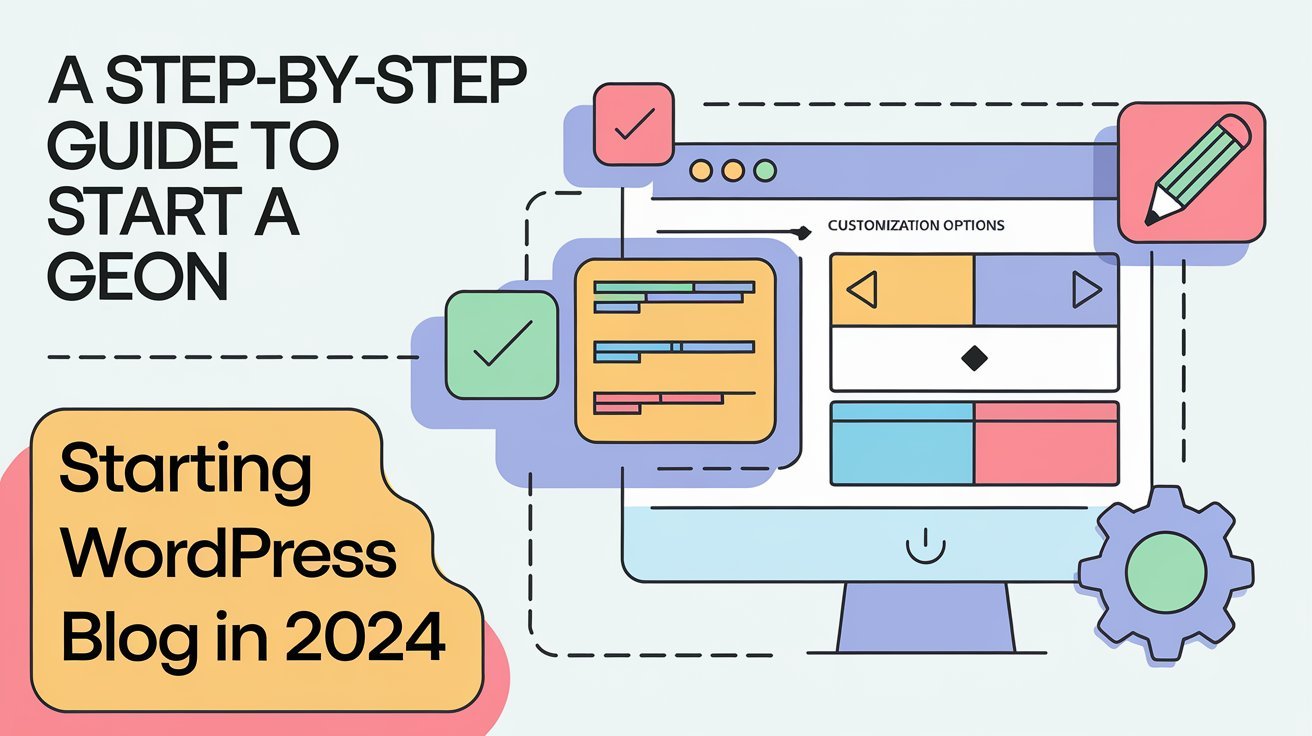Disclosure: I may earn a commission for purchases made through links in this post.
Ready to turn your blogging dreams into reality? This comprehensive guide provides a clear, step-by-step approach to launching a successful WordPress blog. From choosing a hosting plan to promoting your content, we’ll cover everything you need to know.
Starting a blog can be a life-changing decision, offering personal fulfillment and income potential. By choosing the right niche and following the steps outlined here, you can create a blog you love and achieve your blogging goals.
Before we dive in, I recommend checking out these essential resources:
- 9 Essential Things To Do Before Starting a Blog: [Link to article] – This article covers crucial pre-blogging steps like defining your goals, identifying your target audience, and brainstorming content ideas. It helps you establish a solid foundation before investing time and money in your blog.
- How to Choose the Right Niche for Your Blog: [Link to article] – Choosing the right niche is vital for your blog’s success. This article guides you through finding a niche that aligns with your passions, knowledge, and audience interest, ensuring long-term motivation and profitability.
These articles will help you lay the foundation for a successful blog. Once you have a good idea of your blog’s topic and name, and you’re convinced that a self-hosted WordPress blog is the right choice (it is!), you’re ready to proceed!
Note: While I’ve switched my main blogs to BigScoots, SiteGround remains an excellent option for new bloggers. You can compare the two in my BigScoots vs SiteGround post: [Link to article] – This comparison post provides a detailed analysis of BigScoots and SiteGround, highlighting their features, pricing, performance, and customer support. It helps you make an informed decision based on your specific needs and budget.
Step 1: Choose a Hosting Plan
Your hosting provider is the foundation of your blog. I recommend SiteGround: [Affiliate link to SiteGround] – SiteGround is known for its reliable hosting, excellent customer support, and user-friendly interface. They offer various hosting plans tailored to different needs and budgets.
- Visit SiteGround: Go to [Link to SiteGround] and click “Sign Up.” – This takes you to SiteGround’s website where you can explore their hosting plans and features. Familiarize yourself with their offerings before choosing a plan.
- Select a Plan: The “GrowBig” plan offers excellent value for new bloggers. Learn more about choosing the right plan in my How to Choose the Right Host for Your Blog post: [Link to article] – The “GrowBig” plan typically provides more resources and features than the basic plan, allowing your blog to handle increased traffic and storage needs as it grows.
- Click “Order Now”: This will take you to the next step in the signup process, where you’ll choose your domain name.
Step 2: Choose Your Blog Name
- Enter Your Desired Domain Name: Type in your chosen blog name and click “Proceed.” – Make sure the name is relevant to your niche, easy to remember, and reflects your brand identity.
- Check Availability: If your chosen name is available, congratulations! If not, try again until you find a suitable and available name. – SiteGround will check if the domain name is available. If not, they will suggest alternative options or variations.
Tips for Choosing a Blog Name:
- Keep it short, memorable, and easy to spell. – Avoid complex or lengthy names that are difficult to recall or type.
- Avoid hyphens and numbers. – These can make your domain name look less professional and harder to remember.
- Choose a .com domain if possible. – .com domains are the most common and trusted, making them easier for people to remember and find.
- Ensure it reflects your blog’s niche. – Your blog name should give visitors a clear idea of what your blog is about.
Need more help? Check out my post on How to Choose the Perfect Blog Name: [Link to article] – This article provides a detailed guide on brainstorming, evaluating, and selecting the perfect blog name, including factors to consider and common mistakes to avoid.
Step 3: Purchase Your Hosting
- Fill in Your Details: Provide your personal and payment information. – Ensure all information is accurate to avoid issues with your account and domain registration.
- Consider Add-ons: I recommend adding SG Site Scanner for security and Domain Privacy to protect your personal information. – SG Site Scanner helps detect malware and vulnerabilities on your website, while Domain Privacy keeps your personal contact information private in the WHOIS database.
- Click “Pay Now”: You’re now ready to set up WordPress! – Review your order details and confirm your purchase. You’ll receive a confirmation email with important information about your hosting account.
Suggestion: HostArmada and FastComet are currently offering a Black Friday promotion from October 27, 2024, to November 2, 2024, with very attractive prices. You can check them out!
Step 4: Set Up WordPress
- Log in to SiteGround: Go to [Link to SiteGround login] and use the credentials you created. – Access your SiteGround account dashboard to manage your hosting and website settings.
- Set Up Your Site: Select “Set Up Site,” then “Start New Website.” – This initiates the WordPress installation process on your hosting account.
- Choose WordPress: Select WordPress as your platform. – SiteGround offers various website platforms, but for this guide, we’ll focus on WordPress.
- Enter Your WordPress Credentials: Provide your email address and a strong password, then click “Finish.” – This creates your WordPress administrator account, allowing you to manage your blog’s content and settings.
- Wait for Installation: WordPress will be automatically installed on your site. This usually takes a couple of minutes. – SiteGround automates the installation process, making it quick and easy to get your WordPress blog up and running.
Need assistance? SiteGround’s customer support is excellent: [Link to SiteGround support] – If you encounter any issues during the setup process, SiteGround’s customer support team is available 24/7 to provide assistance via live chat, phone, or email.
Step 5: Log in to Your WordPress Account
- Go to Your WordPress Dashboard: Navigate to
https://www.YOURNEWBLOGNAME.com/wp-adminand enter your username and password. – This takes you to your WordPress dashboard, the control panel for your blog where you can manage all aspects of your website.
Note: If you purchased your domain from another provider, it might take 24-48 hours for your domain to propagate. You’ll also need to point your nameservers to SiteGround. – Domain propagation is the process of updating DNS records across the internet. It may take some time for your domain to be accessible worldwide.
Step 6: Install a Theme
A WordPress theme dictates your blog’s design and functionality.
- Choose a Theme: Free themes are available, but investing in a premium theme offers significant benefits in terms of design, SEO, and functionality. – Premium themes often come with more features, customization options, and support from the developers.
- Restored 316 Themes: I highly recommend Restored 316 themes: [Affiliate link to Restored 316] – Restored 316 offers a wide variety of beautiful and functional WordPress themes designed specifically for bloggers, with a focus on feminine aesthetics.
- Install Your Theme: If you choose a Restored 316 theme, follow their comprehensive guides and video tutorials for installation: [Link to Restored 316 guides] and [Link to Restored 316 videos] – These resources provide detailed instructions and visual demonstrations on how to install and customize your chosen theme.
Not sure which theme is right for you? Take the Restored 316 quiz: [Affiliate link to Restored 316 quiz] – This quiz helps you identify the perfect Restored 316 theme based on your preferences, blogging niche, and desired features.
Step 7: Create a Logo
- Design a Simple Logo: You can use Canva [Link to Canva] or PicMonkey [Affiliate link to PicMonkey] to create a professional-looking logo without design experience. – These online tools provide user-friendly interfaces and templates to create visually appealing logos.
- Add Your Logo to Your Header: This adds a professional touch to your blog. – Most WordPress themes allow you to easily upload and display your logo in the header section of your website.
Step 8: Install Plugins
Plugins extend the functionality of your WordPress blog.
Essential Plugins for New Bloggers:
- Akismet: Spam protection for your comments. – Akismet filters out spam comments, keeping your comment section clean and relevant.
- Ninja Forms: Create contact forms. – Ninja Forms allows you to easily create custom contact forms for your website, enabling visitors to get in touch with you.
- Simple Social Icons: Add social media links to your sidebar. – This plugin displays social media icons linking to your profiles, encouraging visitors to connect with you on other platforms.
- Social Warfare: Enable social sharing buttons. – Social Warfare adds visually appealing social sharing buttons to your blog posts, making it easy for readers to share your content with their networks. 5. All In One WP Security: Protect your blog from hackers. – This plugin provides various security measures to protect your blog from malicious attacks and vulnerabilities. 6. Yoast: Optimize your content for search engines. – Yoast helps you optimize your blog posts for search engines by providing on-page SEO guidance and analysis. 7. GDPR Cookie Consent: Ensure compliance with cookie laws. – This plugin displays a cookie notice to your visitors, informing them about your cookie usage and obtaining their consent. 8. WP Recipe Maker: For food blogs, create recipe cards. – This plugin allows you to create visually appealing and structured recipe cards for your food blog posts. 9. VaultPress: Daily backups for your website. [Affiliate link to VaultPress] – VaultPress automatically backs up your website daily, protecting your content from loss due to technical issues or hacking.
To install a plugin:
- Go to “Plugins” > “Add New.” – Access the plugin section in your WordPress dashboard.
- Search for the plugin by name. – Use the search bar to find the specific plugin you want to install.
- Click “Install Now” and then “Activate.” – This installs and activates the plugin on your website.
- Configure the plugin settings. – Most plugins have settings that allow you to customize their functionality.
Learn more about essential WordPress plugins: [Link to article] – This article provides a more detailed overview of essential WordPress plugins, including their features, benefits, and installation instructions.
Step 9: Create Essential Pages
- About Me: Introduce yourself and your blog. [Link to example About Me page] – Share your story, your passions, and what inspired you to start your blog. Connect with your readers on a personal level.
- Contact Me: Provide various ways for readers to contact you. [Link to example Contact Me page] – Include your email address, a contact form, and links to your social media profiles. Make it easy for readers to reach out.
- Privacy Policy: Include necessary legal information. [Link to example Privacy Policy page] – This page should outline how you collect, use, and protect your visitors’ data. It’s essential for complying with privacy regulations.
- Category Index: Organize your blog posts by category. [Link to example Category Index page] – A category index page provides a structured overview of your blog content, making it easier for readers to navigate and find relevant posts.
Step 10: Set Up Your Menus
- Create a Menu: Go to “Appearance” > “Menus” and click “Create New Menu.” – This opens the menu creation section in your WordPress dashboard.
- Add Menu Items: Choose pages, posts, categories, or custom links to include in your menu. – Select the content you want to feature in your website’s navigation menu.
- Arrange Menu Items: Drag and drop items to organize your menu. – Create a logical hierarchy and structure for your menu items.
- Choose Menu Location: Select where you want your menu to appear (e.g., above or below the header). – Most WordPress themes offer multiple menu locations.
Step 11: Set Up Your Sidebar
- Go to Widgets: Navigate to “Appearance” > “Widgets.” – This opens the widget section, where you can manage the content displayed in your sidebar and other widget areas.
- Add Widgets to Your Sidebar: Drag and drop widgets from the left-hand side to your sidebar. – Choose from a variety of widgets to add functionality and content to your sidebar.
- Consider These Widgets:
- Picture and mini bio – A brief introduction and photo of yourself.
- Social media links – Connect with readers on social media.
- Search bar – Help visitors find specific content on your blog.
- Archives – Allow readers to browse your older posts.
- Subscription signup box – Encourage visitors to subscribe to your email list.
- Features and awards – Showcase any recognition or achievements.
- Adverts or affiliate links – Monetize your blog with relevant ads or affiliate products.
- Links to products or services – Promote your own products or services.
Step 12: Edit Your Permalink Structure
- Go to Permalinks: Navigate to “Settings” > “Permalinks.” – This section controls the structure of your blog post URLs.
- Choose “Post Name”: This is the most SEO-friendly permalink structure. – Using the post name in your URL makes it clear and relevant to both search engines and readers.
- Save Changes: Click “Save Changes” to apply the new permalink structure. – This updates your permalink settings for future blog posts.
Step 13: Start Writing Blog Posts!
- Create a New Post: Go to “Posts” > “Add New.” – This opens the WordPress editor where you can create and edit your blog posts.
- Write Your Content: Add your blog post title, content, and images. – Use the editor to format your content, add headings, insert images, and create engaging blog posts.
- Publish Your Post: Click “Publish” to make your post live. – Once you’re happy with your post, publish it to make it visible on your blog.
Need help writing your first blog post? Check out these resources:
- How to Write Your First Blog Post: [Link to article] – This article provides guidance on crafting your first blog post, including tips on choosing a topic, structuring your content, and engaging your readers.
- The 10 Essential Elements of a Successful Blog Post: [Link to article] – This article outlines the key elements that make a blog post successful, such as a captivating headline, compelling introduction, and valuable content.
- Blog Content Section: [Link to Blog Content category] – This category contains various articles and resources on creating high-quality blog content, including tips on writing, SEO, and content strategy.
Step 14: Set Up Your Social Media Accounts
- Choose Your Platforms: Focus on Facebook, Twitter, Instagram, and Pinterest. – These platforms are popular among bloggers and offer diverse ways to connect with your audience.
- Create Your Accounts: Use a consistent username and profile picture across all platforms. – This helps maintain brand consistency and makes it easier for people to find you.
- Optimize Your Profiles: Fill in your bio and other sections with relevant information. – Provide a clear and concise description of your blog and what you offer.
- Introduce Yourself: Write an introductory post on each platform. – Let your followers know who you are, what your blog is about, and what they can expect.
Step 15: Promote Your Blog Content
- Share on Social Media: Create engaging posts for each platform. – Tailor your social media posts to each platform’s unique style and audience.
- Use a Scheduler: Consider using Hootsuite, Buffer, or CoSchedule [Affiliate link to CoSchedule] to schedule your social media posts. – Scheduling tools help you automate your social media sharing, saving you time and ensuring consistent posting.
- Engage with Others: Follow similar accounts and interact with their content. – Building relationships with other bloggers and engaging with their content can help you grow your audience and network.
Congratulations! You’ve now launched your WordPress blog! Keep creating valuable content, promoting your blog, and engaging with your audience. Remember to explore the BLOG CONTENT and GROW YOUR BLOG sections for more resources and guidance:
- Blog Content: [Link to Blog Content category]
- Grow Your Blog: [Link to Grow Your Blog category]
Happy Blogging!







